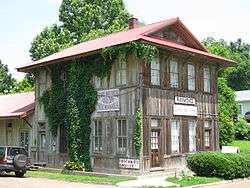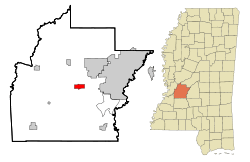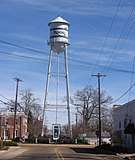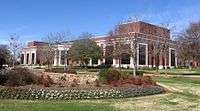Raymond, Mississippi
Raymond is a city in Hinds County, Mississippi, United States. As of the 2010 census, the city population was 1,933. Raymond is one of two county seats of Hinds County (along with Jackson) and is the home of the main campus of Hinds Community College.
Raymond, Mississippi | |
|---|---|
 Little Big Store in Raymond | |
 Location of Raymond, Mississippi | |
 Raymond, Mississippi Location in the United States | |
| Coordinates: 32°15′30″N 90°24′56″W | |
| Country | United States |
| State | Mississippi |
| County | Hinds |
| Area | |
| • Total | 3.00 sq mi (7.77 km2) |
| • Land | 3.00 sq mi (7.77 km2) |
| • Water | 0.00 sq mi (0.00 km2) |
| Elevation | 322 ft (98 m) |
| Population | |
| • Total | 1,933 |
| • Estimate (2019)[3] | 2,115 |
| • Density | 705.24/sq mi (272.28/km2) |
| Time zone | UTC-6 (Central (CST)) |
| • Summer (DST) | UTC-5 (CDT) |
| ZIP code | 39154 |
| Area code(s) | 601/769 |
| FIPS code | 28-61160 |
| GNIS feature ID | 0676505 |
| Website | City of Raymond |
Raymond is part of the Jackson Metropolitan Statistical Area.
History
In 1829, three commissioners, including John B. Peyton, were appointed by U.S. President Andrew Jackson to find a place near the center of Hinds County for the county seat. The current location of Raymond is a ridge about a mile from the center of the county, and was selected because the actual center was low and subject to flooding. The town of Raymond received its charter from the Mississippi legislature on December 15, 1830. Because of its status as a seat of justice and its proximity to the Natchez Trace, Raymond developed quickly into a prosperous small town whose prosperity and small size have continued to this day.
In the late 1840s, Cooper's Well, a property near Raymond with a well that provided sulphured water, was developed into a resort for those seeking the perceived health benefits from its ingestion.
Construction of a new county courthouse was begun at the center of the town square in 1857 and completed in 1859; the work was largely done by enslaved African Americans. The courthouse is still in use as a secondary location of county legal matters (the city of Jackson having become the primary county seat). The Raymond courthouse is considered by many to be a prime example of southern Greek Revival architecture.
The Battle of Raymond was fought by Confederate and Union soldiers near Raymond on May 12, 1863 as part of General Ulysses S. Grant's Vicksburg Campaign during the Civil War. Four days later, the pivotal Battle of Champion Hill was won by Grant's troops and sealed the fate of Vicksburg. Grant stayed at Waverly, the plantation of John B. Peyton, and Union soldiers used St. Mark's Episcopal Church as a hospital. Blood stains can still be seen on the church's floor from that period.
Construction of a water tower was begun in 1903 in the center of the town square. It and the courthouse are landmarks for the town. A small agricultural high school was opened in 1917; it developed as Hinds Community College, which has several sites and the largest student body of any college in the state.
Geography
According to the United States Census Bureau, the city has a total area of 3.0 square miles (7.8 km2), all land.
Demographics
| Historical population | |||
|---|---|---|---|
| Census | Pop. | %± | |
| 1880 | 488 | — | |
| 1900 | 483 | — | |
| 1910 | 579 | 19.9% | |
| 1920 | 500 | −13.6% | |
| 1930 | 547 | 9.4% | |
| 1940 | 641 | 17.2% | |
| 1950 | 1,259 | 96.4% | |
| 1960 | 1,381 | 9.7% | |
| 1970 | 1,620 | 17.3% | |
| 1980 | 1,967 | 21.4% | |
| 1990 | 2,275 | 15.7% | |
| 2000 | 1,664 | −26.9% | |
| 2010 | 1,933 | 16.2% | |
| Est. 2019 | 2,115 | [3] | 9.4% |
| U.S. Decennial Census[4] 2013 Estimate[5] | |||
As of the 2010 United States Census, there were 1,933 people living in the city. The racial makeup of the city was 53.3% Black, 43.9% White, 0.2% Native American, 0.4% Asian, 0.1% Pacific Islander and 0.8% from two or more races. 1.2% were Hispanic or Latino of any race.
As of the census[6] of 2000, there were 1,664 people, 469 households, and 317 families living in the city. The population density was 562.1 people per square mile (217.1/km2). There were 498 housing units at an average density of 168.2 per square mile (65.0/km2). The racial makeup of the city was 57.93% White, 41.17% African American, 0.06% Native American, 0.42% Asian, and 0.42% from two or more races. Hispanic or Latino of any race were 0.96% of the population.
There were 469 households out of which 28.6% had children under the age of 18 living with them, 43.1% were married couples living together, 20.7% had a female householder with no husband present, and 32.4% were non-families. 29.6% of all households were made up of individuals and 11.7% had someone living alone who was 65 years of age or older. The average household size was 2.32 and the average family size was 2.89.
In the city, the population was spread out with 15.4% under the age of 18, 40.3% from 18 to 24, 17.2% from 25 to 44, 15.4% from 45 to 64, and 11.7% who were 65 years of age or older. The median age was 22 years. For every 100 females, there were 119.8 males. For every 100 females age 18 and over, there were 123.5 males.
The median income for a household in the city was $36,667, and the median income for a family was $42,639. Males had a median income of $31,106 versus $21,953 for females. The per capita income for the city was $12,615. About 17.8% of families and 21.6% of the population were below the poverty line, including 39.4% of those under age 18 and 9.6% of those age 65 or over.
Government and infrastructure
The United States Postal Service operates the Raymond Post Office.[7]
The Mississippi Department of Human Services operates the Oakley Training School in unincorporated Hinds County, near Raymond.[8]
Education
Hinds Community College has a Raymond campus.
Residents are within the Hinds County School District, and are zoned to Raymond Elementary School, Carver Middle School, and Raymond High School.[9]
Jackson Hinds Library System operates the Raymond Public Library at the Hinds Courthouse annex.[10]
Notable people
- Muna Lee, Pan-American poet and first wife of Luis Muñoz Marín (first democratically elected governor of Puerto Rico).
- Jeremy Williams, American player of Canadian football
- John Bell Williams, governor of Mississippi from 1968 to 1972, was born in Raymond; he formerly served in the United States House of Representatives.
Gallery
 Cooper's Well, circa 1900
Cooper's Well, circa 1900 Cooper's Well Resort, circa 1900
Cooper's Well Resort, circa 1900 Raymond Courthouse
Raymond Courthouse Raymond water tower
Raymond water tower Cain Cochran Hall on the Raymond Campus of Hinds Community College
Cain Cochran Hall on the Raymond Campus of Hinds Community College
References
- "2019 U.S. Gazetteer Files". United States Census Bureau. Retrieved July 26, 2020.
- "U.S. Census website". United States Census Bureau. Retrieved 2014-10-21.
- "Population and Housing Unit Estimates". United States Census Bureau. May 24, 2020. Retrieved May 27, 2020.
- United States Census Bureau. "Census of Population and Housing". Retrieved October 21, 2014.
- "Population Estimates". United States Census Bureau. Retrieved 2014-10-21.
- "U.S. Census website". United States Census Bureau. Retrieved 2008-01-31.
- "Post Office™ Location - RAYMOND." United States Postal Service. Retrieved on February 1, 2011.
- "Division of Youth Services Archived 2010-01-13 at the Wayback Machine." Mississippi Department of Human Services. Retrieved on July 1, 2010. "2375 Oakley Road | Raymond, MS 39154."
- "attendance_zone.jpg." Hinds County School District. July 21, 2011. Retrieved on December 29, 2018.
- "Raymond Public Library." Jackson Hines Library System. Retrieved on December 29, 2018.
